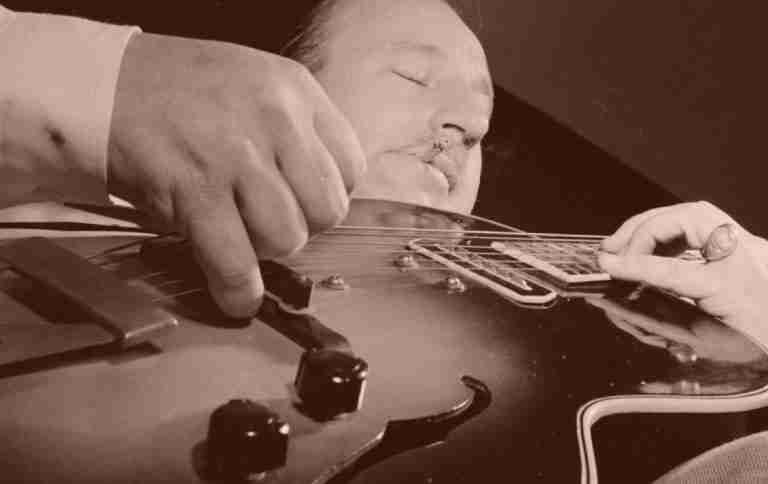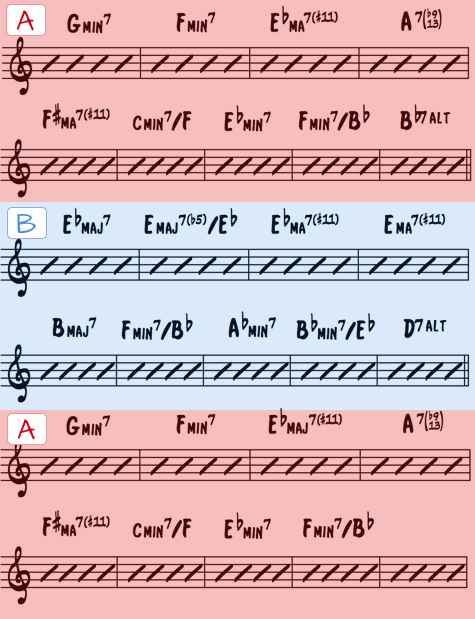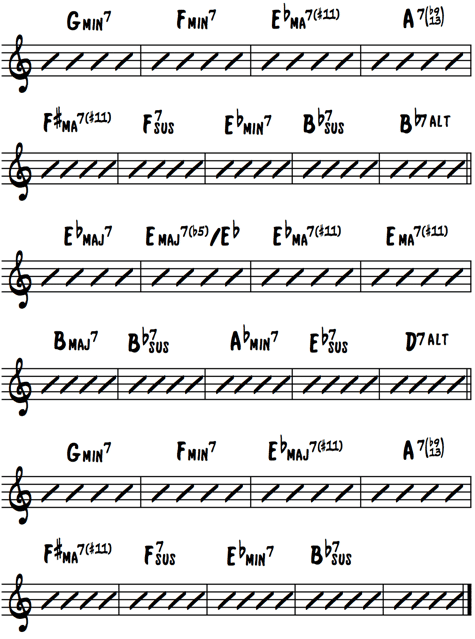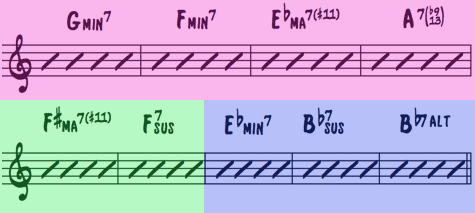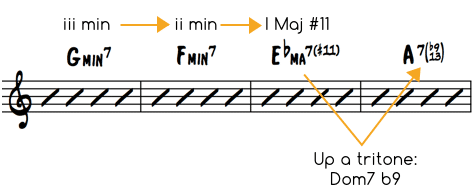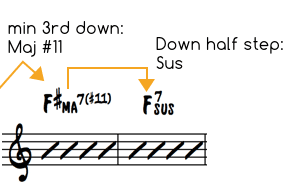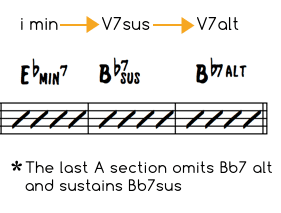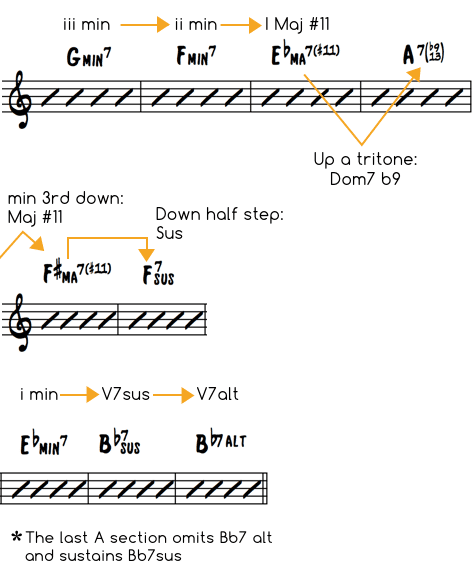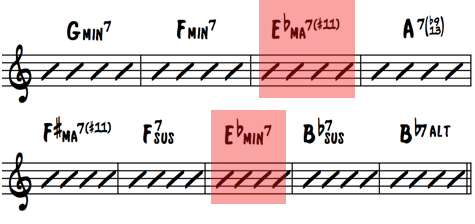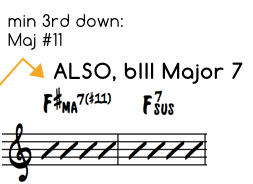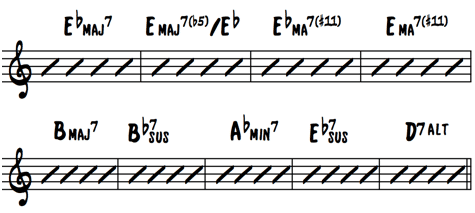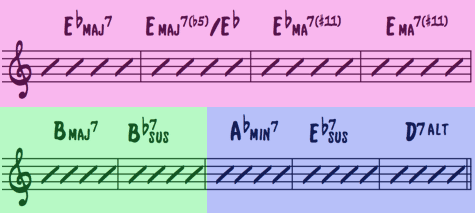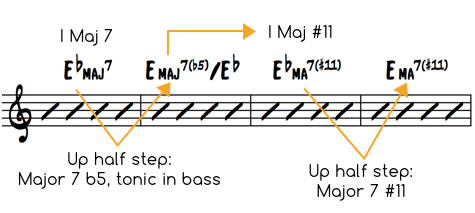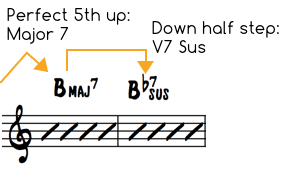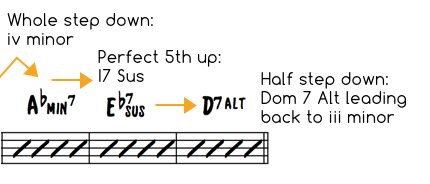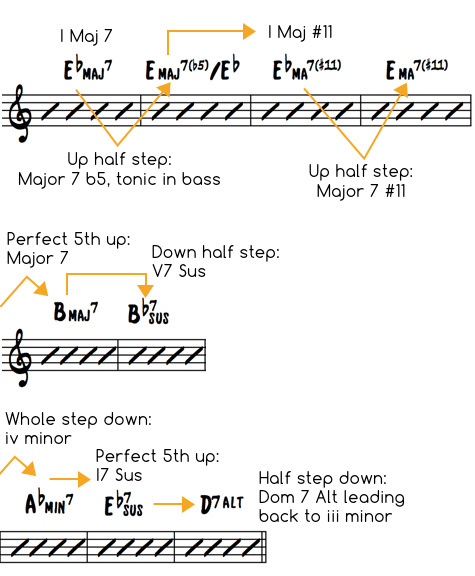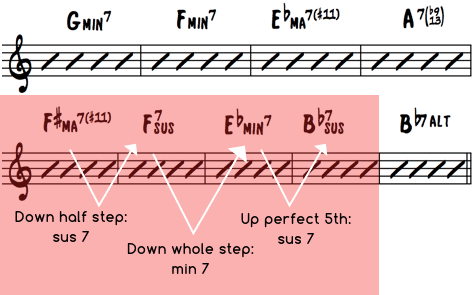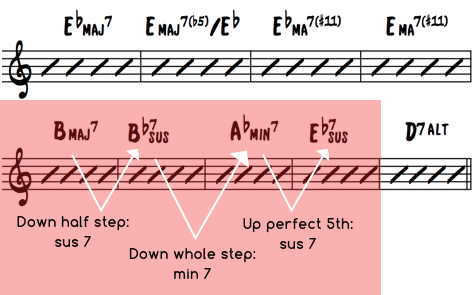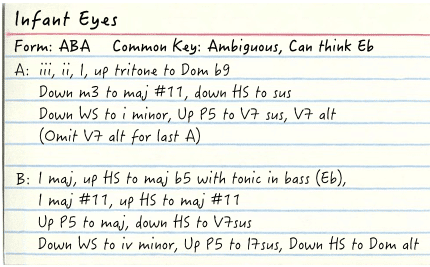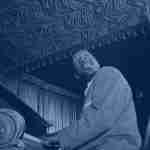Some tunes seem to make absolutely no sense, like the chords changes are some random crazy collection of complex sounds…But with a little know-how, using the same tactics we showed you in our recent lesson on learning tunes quickly, even the most difficult tunes can be deciphered in just a few minutes.
Today’s lesson comes from a recent question we received from a reader:
”I enjoyed your latest post and would like to start memorizing standards this way. However, lots of standards don’t seem to fit this method…or rather I can’t see how to fit them. Case in point, the tune ‘Infant Eyes’. Could you show how to apply the method to a ‘non-standard’ song?
That’s a great question, and if you haven’t read our recent post on how to learn the chord changes of a tune in less than 5 minutes, make sure to check that out before diving into this lesson.
Once you have a firm grasp on the method we use there, you’re ready to apply the concepts to something a little trickier…something like Wayne Shorter’s beautiful composition Infant Eyes.
https://www.youtube.com/watch?v=sBTaiFR7LJQ
These chords make no sense…
When you first look at the changes to this tune, the common reaction is, “What the ^%$# is going on?!?!?!”
This is a complicated tune in the sense that at first glance, there are few typical progressions like ii Vs or other common chunks of chords that we are familiar with.
In fact, even the key center of the tune is ambiguous.
And, if that weren’t enough, there are all these weird chords with slashes and upper extensions like #11.
So, how do we even approach a tune like this when we can barely even understand what’s going on?
First and foremost, start with the easiest way to simplify a tune in your mind. Look for the form…
In the case of Infant Eyes, as you can see, the form is ABA where each section lasts 9 bars. That means that all we have on our plates are two sections of 9 bars long to figure out.
But just because it’s only 18 bars doesn’t mean that these progressions aren’t tricky…
Next, figure out the things you don’t understand
In our recent lesson, we worked through What is This Thing Called Love? which makes use of many familiar harmonic elements. Because we’re already familiar with a lot of what’s there, we can jump into the other parts of the process:
- Creating short memorable sentences
- Defining and thinking of target chords
- Discovering alternate relationships
And, we can then go into making a tune index card for the tune —if any of this is unfamiliar, review our lesson from a few weeks ago.
But, when we’re dealing with more complicated harmony that has many unfamiliar elements in it, we have to add a step before all of these.
We have to figure out the chords we don’t understand BEFORE we start improvising on it.
I know it sounds like common sense, but everyone seems to ignore this, even me. I remember opening the Real Book to a random difficult tune of which I barely understood the chords to, throwing on a background track, and improvising for hours.
Sure, it was fun, but I was fumbling over the same chord changes and reinforcing bad habits over them, rather than spending 20 minutes figuring out the specific things I didn’t understand.
It doesn’t take that much time to gain a basic understanding of even the most daunting of chords. So, let’s take a look at some of the scary chords in Infant Eyes…
Slash chords in Infant Eyes
The first thing that stands out are all those chords with a slash and an extra symbol. They’re called “Slash Chords” and are way easier to understand than you might think. Essentially all they are is a chord on the left, with a bass note on the right.
So if you have “C minor 7 / F” that means the chord is a C minor 7 chord with an F in the bass, instead of the usual C.
Not that scary at all…
The whole point of slash chords and what makes them tricky is that with each one, the composer is describing a very particular sound, and if you don’t know what the sound is that they’re describing, well, you’re a little lost.
In the case of Infant Eyes, all the slash chords in the A sections describe a “Sus Chord,” and lucky for you, we’ve talked before about sus chords here.
Because all these slash chords in the A section are sus chords, for memorization and simplification purposes, I think of a sus chord for all these slash chords and will notate them as such later in our memorization process.
So…
C min7 / F becomes F7 sus
F min7 / Bb becomes Bb7 sus
Bb min7 / Eb becomes Eb7 sus
But, what if you wanted to figure this out on your own, that these slash chords were describing sus chords?
With any chord you don’t understand, sit at the piano and play it.
What does it sound like? If you’ve trained your ear you should instantly be able to hear whether it’s major, minor, sus, altered, or anything else– yes, if you’ve drilled these sounds in your mind, it’s like hearing a friend’s voice: you just know what it is without any thought.
And if you know how to think about and analyze chord-tone relationships, then you’ll quickly see at the piano how each note in the chord is acting in relation to its root.
Every chord can be described in some way.
By spending a few minutes at the piano with the chords you don’t understand, you’ll have an “AHA” moment and realize, “Oh, that’s all it is….”
The other slash chord occurs in the second measure of the bridge:
E Major 7 b5 / Eb
Many charts will say this chord is E major 7 / Eb and forget about the b5, not quite the sound we’re after, which brings me to another VERY important point.
With tunes like this, you have to listen to the original recording and determine for yourself what it is you hear.
Sure, I don’t expect you to be able to figure out all these chords on your own, but spend some time and double check the accuracy of your lead sheet by slowing down the tune and playing along with the original recording—I’ll do another lesson on this, walking you through the whole process with this tune because it’s a bit involved but for now, know that a crucial step in understanding, memorizing, and playing over these chords entails studying the actual chord voicings that Herbie Hancock plays on this tune.
Back to slash chords…
This slash chord, E Major 7 b5 / Eb, is a very unique and beautiful sound, and it’s easy to think about as well. It’s just a Major 7 chord with a b5 (same as the #11, the b5 is notated to specify that the 5th is flatted in the voicing instead of adding the #11th to a voicing with the 5th), and instead of the root, the 7th is put in the bass.
There are a few ways to think about this. Most theory books will tell you to play Eb Phrygian, which is completely cool if it works for you.
Or if you prefer, you could also think lydian— check this lesson out for a ton of lydian ideas — if you think of E Major 7 #11. In this case, you’d essentially just think about the left side of the chord, which works as well.
Subtle dominant chord voicings in Infant Eyes
Besides these slash chords, Infant Eyes makes frequent use of dominant chords with alterations (a great lesson on dominant vocabulary here) and Major #11 chords, both of which are simple variations on their basic counterparts, dominant and major, respectively.
In this tune, however, the specific dominant voicings Herbie uses highlight particular upper structure chord-tones (9 11 13) and altered chord-tones (b9 #9 b5 #5).
Sometimes he plays a dominant chord voicing containing the b9 and the natural 13th, and other times he plays a dominant chord voicing with the #9 and the b13 (same as #5).
As I mentioned before, for tunes like this where each chord is a very defined sound and every little alteration contributes to the tune, it’s important to listen to the original recording and figure out the subtleties in the chord voicings.
For now, I’ve notated for you where Herbie tends to (I say tends because he doesn’t always play the same chord voicing each time around) use a voicing containing the b9 and natural 13th, or the #9 and b13th (notated as ALT), but know that you’ll eventually have to dig into the actual chord voicings a comping instrument is playing (something we get into in The Ear Training Method) if you want to hear and play over these dominant chords effectively.
And that’s it as far as basic chord understanding goes for Infant Eyes. It’s not as much as you may think, but before you begin to play on any tune, you should aim to:
- Study the actual chord voicings on the recording
- Understand the SOUND of each chord
- Mentally understand the construction of each chord
- Be able to play a very basic chord voicing of each chord at the piano
If any chord gives you a “What the $#%# is that?” You’re not done with your pre-chord-study.
Short memorable sentences with tricky tunes
Once you understand each chord individually, it’s time to understand the chords in the context of a progression, and to do this, as we did in our recent lesson, we construct short memorable sentences that give the chords context and meaning, and associate this context and meaning to information already in your head—knowledge of basic progressions.
But, as you now know by now, it’s a bit difficult to construct a sentence when the tune doesn’t even have a recognizable key?!?!?
So, what do you do?
Well, you do what any great problem solver would do…
You think outside the box and impose your own will on the problem.
Let’s begin to look at how we’d do this for the A section of Infant Eyes…
The A section is an unusual 9 bars long and doesn’t necessarily sound like it functions in any particular key. Some people will say it’s in Eb and others will say Bb.
Like we said in the previous lesson, we’re trying to get these changes in our head so we never have to look at them again in the Real Book, so we’re primarily concerned with finding a way that we can easily think about them, even if it’s not precisely how we hear the progression.
For me, that’s thinking of the whole tune in Eb. When a tune’s key is ambiguous, we just have to make some decision on how we’re going to think about it. This would ideally match up with how we hear the tune, but in the case of tricky tunes like this, ideal is not what we’re after. We’re after any way to conceptualize these change because they’re not easy to think about.
Here’s the secret to thinking about a tune’s changes that function more individually than a cohesive whole:
Use both functional analysis and intervallic relationships to create your short memorable sentences
AND…
Break up each section into several pieces that are easier to recall than the entire section.
Let’s do this with the A section to give you an idea of what I mean…
Creating short memorable sentences for the A Section of Infant Eyes
We’ll break up the A section into 3 pieces:
Using both functional analysis and intervallic relationships makes the first 4 bars easy.
G minor and F minor could function as the iii minor and the ii minor moving to the I chord, Eb major. Remember, with tricky tunes that have ambiguous key centers, we’re making this stuff up to aid in our memorization process. We’re imposing our own structure on to it, not trying to determine what the composer was thinking or firmly declare why a chord functions a certain way.
And the 4th chord is where our intervallic trick comes in. That chord is a dominant b9 13 chord a tritone up (or down, same thing), from the tonic (Eb major)
Our sentence for the first four measures is easy:
iii minor, ii minor, I major #11, up a tritone to Dominant b9 13
Say it a few times…
“Three minor, Two minor, One Major #11, up a tritone to Dominant b9 13”
Easy right?
Once you learn this and our comfortable with it, you could make this even more concise by eliminating the “minor” on the iii and ii because those are the standard qualities attached to iii and ii in a major key, and you could eliminate the “major” after I if you like and “#11” if you have the ability to remember and to hear this alteration.
You can even shorten the “b9 13” to “b9,” and create a schema in your mind that b9 implies the natural 13th. I like to use “b9” for an abbreviated version of this chord. All of this is up to you, but I want to give you an idea of how you can simplify the changes to the point that they’re super easy to think about…
iii, ii, I, up a tritone to Dominant b9
Now say this shortened version a few times…
“Three, Two, One, up a tritone to Dominant b9”
Moving to the next two bars…
I think intervallically because I want to move from the dominant chord somewhere, rather than thinking of the next chord as related to our self-appointed tonic, Eb major. That’s just my preference.
So, to get to measure 5, I think, “down a minor 3rd to major #11” and for the measure after that, “down a half step to a sus 7 chord”
And for the final three measures, I move back to thinking functionally rather than intervallically because thinking of the parallel minor is always easy:
I parallel minor, V7 sus, V7 alt
I know, it sounds like a lot, but it’s actually pretty easy because we’ve split the 9 tricky bars up into three manageable pieces that are easy to navigate between.
Let’s put the whole A section together in a simplified version to get an idea of how easy it really is, and we’ll simplify the sentences even more by abbreviating our intervals— minor 3rd = m3, major 3rd = M3, half step = HS etc…
iii, ii, I, up tritone to Dom b9
Down m3 to maj #11, down HS to sus
i parallel minor, V7 sus, V7 alt
Say each of the 3 pieces over and over until you’ve got them solid. Then connect them, one after the other and verbally go through all 9 bars over and over.
The form of the tune is ABA, the last A section simply leaves out the last chord, so with this work, you’ve just learned 66% of the tune.
What about target chords and alternate pathways?
When we learned What is This Thing Called Love? it was clear that there were chords in the progression that we were headed toward, in other words, there were target chords.
When a tune shifts from chord to chord and has an ambiguous key center, target chords play less of a role in the memorization process.
Still, there are target chords that we can use more as “important flags” to make sure we’re on the right track.
For the A section, obviously our I major chord (Eb major) is a target chord that we should have in our mind. The other chord I would note as being target chords is the parallel minor because it helps us get through those last 3 bars.
Now, in terms of alternate pathways, on tricky tunes, I like to combine alternate pathways with the way I’m already thinking about the chords to ensure that I don’t make a mistake. In the A section, I may do this at measure 5.
The way that we’re thinking about getting to measure 5 is:
Move a minor 3rd down to a major #11 chord, A7 to F# major, but another way to think about it—an alternate pathway— is move to the bIII major#11 of the key (F# major #11 is the bIII major#11 in Eb).
Having this relationship in mind simultaneously may help you make sure that you moved correctly using your intervallic relationship, and you may want to add this (the bIII major #11) to your list of target chords that you think of upfront as well.
Remember, all of this is meant to help you think through the chord changes in any key. If it complicates your thinking, don’t use it. If it makes it easier, do use it. If you come up with something that works better for you, use that instead.
Now let’s take a look at the bridge of Infant Eyes…
Creating short memorable sentences and using simultaneous alternate pathways for the bridge of Infant Eyes
The bridge of Infant Eyes is again 9 bars like our A section, and doesn’t seem to use standard progressions either.
Using Eb major again as our tonic and thinking intervallically makes this pretty easy to think about if we split it into 3 pieces again:
For the first 4 measures…
I major, up a half-step major b5 with tonic in the bass (Eb),
I major #11, up a half-step major #11
You can always make your sentences as concise as you like as we did before:
I maj, up HS maj b5 tonic bass, I maj #11, up HS maj #11
Then for the next two measures…
Up P5 to major, down HS to V7sus
Notice that in the case of “down a half step to V7sus” I combine intervallic (down a half step) and functional (V7sus) thinking to give me two simultaneous ways to get to the chord. In other words, I’m taking two pathways of getting to the chord and combining them to reinforce how I mentally get there.
You could just think of “V7 sus” or “down a half step to sus”, but sometimes it may help you to use this combined method, thinking instead: “down a half step to V7 sus”.
And the final three measure…
down WS to iv minor, P5 up to I7sus, down HS to Dom7alt (which leads to iii minor in the following bar of the last A Section)
Again, I’m combining both intervallic and functional pathways. You can use just functional or just intervallic pathways, or a combination of both if you like.
Let’s put the entire bridge together and make our sentences more concise with the abbreviations for intervals—half step = HS, whole step = WS etc…
First, what are our target chords? For the bridge, you want to have the I major chord in your mind (Eb), the major #11 chord a half step up (E), and the major chord a 5th up from there (B). With these 3 chords in your mind, it’s easy to navigate your way through the bridge. Here’s all of our sentences:
I maj, up HS maj b5 tonic bass, I maj #11, up HS maj #11
Up P5 to maj, down HS to V7sus
Down WS to iv minor, Up P5 I7sus, Down HS to V7alt
Try to think through each of these pieces quickly in a few keys…
Even more relationships…
One more thing about this tune that you might have noticed if you were paying close attention is that the A section and the bridge actually use some of the same chord relationships, simply shifted to a new key.
Measures 5, 6, 7, and 8 of the A section are identical to measures 5, 6, 7, and 8 of the bridge, just shifted up a perfect 4th (or down a perfect 5th, same thing).
When you start to be able to think intervallically without making your brain explode, you may want to capitalize on this relationship.
Instead of thinking of measures 7 and 8 in a functional way for the A section like we did— i parallel minor and V7 sus — you could think intervallically the whole time:
Maj 7 #11, down HS to sus, down WS to minor, up P5 to sus
If you get this down, then when you get to the bridge, you can think of the same relationships for measures 5 – 8:
Maj 7, down HS to sus, down WS to minor, up P5 to sus
Now, I didn’t show you this upfront for a couple reasons…
First, I wanted to gradually introduce you to the idea of thinking intervallically. Most of the time, we’re so used to thinking about how every chord functions, that thinking a different way can be quite complex.
And secondly, I wanted to give you choices and show you that there are many different ways to think about chord changes, especially if you learn to mix both functional and intervallic ways of thinking.
Always look for and be aware of relationships between each chord and groups of chords.
Use what works for you, but expand and improve your musical mind by trying new ways of thinking through the changes.
Make a “Tune Index Card”
Now that you have your short memorable sentences defined and can easily use them, go ahead and draw them up on an index card for review:
As you make tune index cards, place them on your nightstand and right before you go to sleep, glance at them for a few minutes. This exercise will help the changes cement themselves into your mind while you sleep.
Time to think through the changes in all keys
Ok, here’s the real test…
Let’s think through the changes of Infant Eyes in the key of Db.
First the A section…
Our target chords are going to be I major (Db major) and the parallel minor is C# minor. We also want to have our bIII major #11 chord in mind, which is E major.
Now, fill in our sentences:
iii, ii, headed to Db maj, up a tritone to Dom b9
F min, Eb min, Db maj, up a tritone to G7b9
Down m3 to maj #11, down HS to sus
Down a minor 3rd to E maj #11, Eb7 sus
Down WS to i minor, Up P5 to V7 sus, V7 alt
C# minor, Ab7 sus, Ab7alt
Not as difficult as you might have expected…
Next, the bridge using our target chords I major (Db major), the major #11 chord up a half step (D major #11), and the major chord a perfect 5th up from there (A major)
I maj, up HS to maj #11 tonic bass, I maj #11, up HS to maj #11
Db maj, D maj b5 / Db, Db maj #11, D maj #11
Up P5 to maj, down HS to V7sus
A maj, Ab7 sus
Down WS to iv minor, Up P5 to I7sus, down HS to Dom7alt
F# min, Db7 sus, C7 alt (which leads us back into the F minor of the A section)
And that’s it! I know it’s not easy at first, and that’s just the reality, that some tunes are just hard to conceptualize. But, that doesn’t mean there aren’t tools that can’t help.
Between functional and intervallic thinking, you will be able to determine many easy-to-think-about pathways leading you from one point in a tune’s progression to another, and you’ll be able to craft meaningful sentences that lead you through the changes.
Once you’ve studied these sentences or come up with your own, sit at the piano and play through the changes while verbalizing out-loud your instructions. This is a very important exercise for you to do.
You must learn to hear these chords and see them in your mind.
See, hear, and feel the relationships.
It’s my hope that the example we went through today, although difficult, gave you a little insight into how you might approach the tricker tunes that you’ve been struggling with, and give you the confidence needed to figure them out. While it may take you way longer than 5 minutes right now, with some on-going practice, you will be able to use this method to dramatically speed up the time it takes you to learn a hard tune.
Now go have some fun conquering one of those complex tunes that you’ve always wanted to learn!
